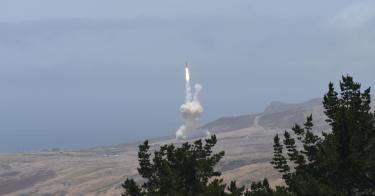Imagine a world in which North Korea can launch a nuclear-armed ballistic missile at the U.S., and we have absolutely no missile defense.
We would be living in that world today if President George W. Bush had not withdrawn the U.S. from the Anti-Ballistic Missile (ABM) Treaty, which had barred us from deploying a comprehensive missile-defense system.
The U.S. withdrawal was unpopular with the arms control crowd, who attributed almost magical peacekeeping properties to the pact — despite Moscow’s blatant violations of its terms. But Mr. Bush had no interest in perpetuating U.S. vulnerability to ballistic missiles attack.
“We know that the terrorists and some of those who support them seek the ability to deliver death and destruction to our doorstep via missile,” Mr. Bush said. “I cannot and will not allow the United States to remain in a treaty that prevents us from developing effective defenses.”
A mere five months later, the U.S. and Russia signed an unprecedented arms reduction treaty. More importantly, Mr. Bush rapidly deployed the Ground-Based Midcourse Defense system. Today, it is the only system that can stop a North Korean missile headed for the U.S. homeland. The latest demonstration of this capability came in May.
The successful test of the system was timely, to say the least. Earlier this year North Korea launched a missile capable of reaching most of the continental U.S.
The Hermit Kingdom has advanced its nuclear weapon capabilities, too. Last month it tested a hydrogen bomb and declared it missile-ready. It also threatened to detonate the bomb over the Pacific Ocean.
Where would we be with no Ground-Based Midcourse Defense system in place? President Trump would be left with only three options for responding to an imminent North Korean long-range missile attack.
First, he could use military force to destroy the missile on its launch pad. But the U.S. might not have enough advance notice to strike before the missile launches. North Korea has developed rail-mobile ballistic missiles that are incredibly hard to find. For decades the regime has been building tunnels and caves to make this type of pre-emptive U.S. attack extremely difficult. Moreover, North Korea would almost certainly treat a launch-site attack as an act of war. It would put all of our allies in the region at significant peril.
As for the second option, the president would have to look on as an adversary prepares its missile strike and uses the act of preparation as a threat to coerce the U.S. to back down in a crisis scenario. But backing down would cost the U.S. credibility among its allies around the world. And if they felt the U.S. was no longer willing to strike forces threatening their existence, they could move rapidly to acquire their own nuclear weapons. So much for nonproliferation.
The third, and worst, option: the North Korean missile launches. Depending on the scale and type of the attack, the U.S. would be paralyzed for weeks, if not months. During that time, our adversaries would move swiftly to reshape the world to their liking. And a world remade in the image of North Korea, Iran, China or Russia would not be conducive to life, liberty and the pursuit of happiness.
Fortunately, the Ground-Based Midcourse Defense system is in place. But the threat grows daily.
We must continue to improve our missile defenses, upgrading the system’s sensor and discrimination capabilities. We must invest, too, in technologies such as the Multiple Object Kill Vehicle that will make the existing interceptors more efficient. And we must ensure we have enough interceptors to keep the pace with the threat.
Our missile defenses work. But to keep up with our adversaries well into the future, we must get serious about building a comprehensive, layered missile defense system. That means investing in advanced technologies, including space-based interceptors and directed-energy weapons. Providing for the common defense has never been more challenging — or more necessary.
This piece originally appeared in The Washington Times



